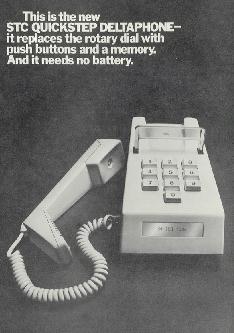In the early Seventies, the Quickstep Deltaphone was the smallest self-contained version of a press-button phone which didn't need a battery to power the electronics for the keypad. |
STC's advert for the press-button self-contained Trimphone. The name 'quickstep' was probably used because you could enter the numbers into the keypad as fast as you liked. The electronics would store the numbers and pulse them out at 10 p.p.s. to the exchange line which was still likely to have been served by a Strowger exchange. MF or tone-tone dialling was to come later.
Ads
| Advert from Post Office Telecommunications Journal Winter 1973/74 | |||
 |
|
||
| The STC QUICKSTEP DELTAPHONE is the pushbutton
version of the DELTAPHONE-the highly successful premium
telephone in international use. It is designed for the British Post Office, and is suitable for all loop-disconnect signalling systems. It requires no modifications to the exchange. It is the first instrument of this type to do away with the need for an internal battery or a mains power connection. Because of its attractive new features and appearance, it now offers telephone administrations throughout the world an immediate opportunity to earn increased revenue. This is the telephone of the future. Speedier operation and a built-in memory. However quickly the buttons are pressed, the QUICKSTEP DELTAPHONE'S memory will store the numbers keyed, and will simultaneously pulse them out at a speed acceptable to the exchange. More design features for the user. The QUICKSTEP DELTAPHONE is elegant, compact and lightweight-ideal for both residential and business environments. The pushbuttons are double moulded for permanence of numerals and the keying surface is slightly depressed to eliminate finger slippage. The normal ringing tone of a telephone is replaced with a distinctive 'warble' -the volume of which can be controlled. There are facilities for operator recall and shared service, and various signalling arrangements can be provided between extensions by the addition of an extra switch, operated by the cradle bar. The cradle bar can be used as a carrying handle during use. The set is available in three two-tone colour combinations. New technical features for the PTT. The keyblock has a collapse action making keying a definite movement. This reduces user errors. Reliability and long life are ensured-the keyblock has been laboratory tested to 200,000 operations per button without failure. The QUICKSTEP unit is built around an STC-designed microelectronic integrated circuit containing the equivalent of 1600 transistors. This circuit acts acts as a buffer memory and controls the timing of the pulses. Power for the unit is drawn from the line during signalling, no mains or battery power being required. The uniquely designed handset has an acoustic horn leading to the transmitter capsule at the earcap end. The tone caller comprises a transistor oscillator and a miniature output transducer. The loudness of the output is controlled by a four-position switch. QUICKSTEP and DELTAPHONE are registered trademarks of Standard Telephones and Cables Limited. |
|||
Transmission
The Quickstep Deltaphone meets British Post Office transmission performance requirements with no degradation, on lines up to 1000 ohms loop resistance with an overall electro-acoustical performance substantially equal to that of the BPO types 706, 746 and Trimphone telephone sets. It is therfore suitable as a direct replacement for these telephone sets, or can be used in conjunction with them. Automatic equalization of the telephone set efficiency for varying lengths of loop is provided by the transmission regulator which reduces excessive loudness on short lines without imparing fully efficiency on long lines.
Receiver
Rocking: Armature type REC4041R-BPO No. 3T Frequency Response: flat within +or - 3 dB from 200 Hz to 3.5 kHz (rising slightly with frequency). Sensitivity: (at 1 kHz) 45 dB relative to 1 dyne-cm2 per square root of available power in milliwatts. Standard Impedance: 150 ohms at 1 kHz.
Transmitter
Type TMR4039D; BPO No. 15 The small carbon transmitter and the acoustic horn system contained within the handset together have an overall frequency response and sensitivity similar to those of modern high-quality carbon transmitters for handsets.
Frequency Response: the efficiency of the horn rises with frequency and this compensates for the falling response of the transmitter above its resonace.
Sensitivity: (at 1kHz) in free field of 32 dyne-cm2 and at British modal distance from the artificial mouth-84 dB relative to 1 microvolt open-circuit voltage per dyne-cm2.
Talking Resistance: 85 ohms at 47 mA feed current.
Colours Available:
| Quickstep Deltaphone | Handset | Body | STC Order Code |
| Grey | Heron Grey | Dove White | 66LAU69AAA |
| Blue | Dolphin Blue | Ocean Blue | 66LAU69AAB |
| Green | Olive Green | Quaker Grey | 66LAU69AAC |
Dimensions and weights:
| Height overall | 117 mm (4.6 in) | |
| Depth, front to back | 216 mm (8.5 in) | |
| Width | 109 mm (4.3 in) | |
| Handset cord length | Coiled: Fully extended: |
254 mm (10 in)
1372 mm (4 ft 6 in) |
| Line cord | Coiled: Fully extended: |
1372 mm (4ft 6 in) 3050 mm (10 ft) |
| Handset weight | (excluding cord) | 115 g (4oz) |
| Telephone set | (excluding line cord) | 650 g (23 oz) |
| Total weight (inclusive of both) cords and terminal block) |
910 g (32 oz) | |
| Protected label slot | 61 mm x 15 mm (2.4 in x 0.59 in) |
|
All logos and trade marks are the property of their respective owners and are used on the Light Straw site(s) for review only. Students and researchers are recommended to make their own independent enquiries as to the accuracy of the information contained therein.